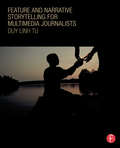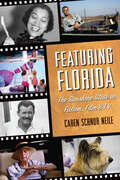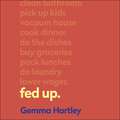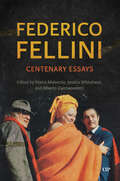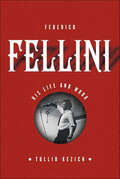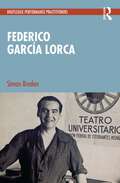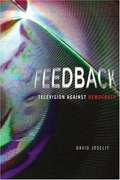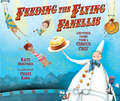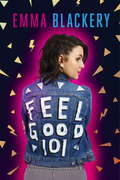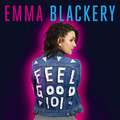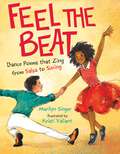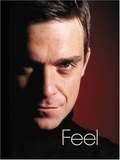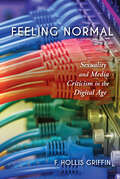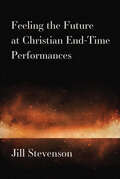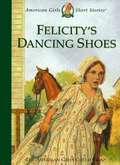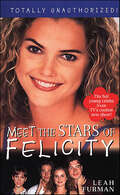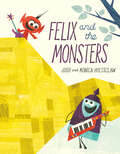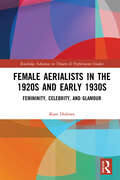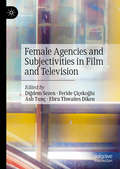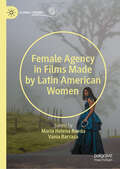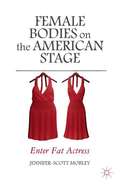- Table View
- List View
Feature and Narrative Storytelling for Multimedia Journalists
by Duy Linh TuFeature and Narrative Storytelling for Multimedia Journalists is the first text that truly focuses on the multimedia and documentary production techniques required by professional journalists. Video and audio production methods are covered in rich detail, but more importantly, various storytelling techniques are explored in depth. Likewise, author Duy Linh Tu tackles the latest topics in multimedia storytelling, including mobile reporting, producing, and publishing, while also offering best practices for using social media to help promote finished products. Whether you're a student, a professional seeking new techniques, or simply looking to update your skills for the new digital newsroom, this book will provide you with the information and tools you need to succeed as a professional journalist. Integrated: The lessons in this book deftly combine traditional media production principles with storytelling craft. It is written with the perspective of modern professional journalists in mind. Practical: While rich with theory, this text is based on the real-world work of the author and several of his colleagues. It features Q&As with some of the best editors and video producers from top publications, including NPR, Vice, and Detroit Free Press, as well as profiles of leading video news organizations such as Frontline, Mediastorm, and Seattle Times. Proven: The author uses pedagogy from the world-renowned Columbia Journalism School as well as case studies from his own award-winning work. Interactive: The text is exercise- and drill-based, and the companion website provides multimedia examples and lesson files, as well as tutorials, case studies, and video interviews.
Featuring Florida: The Sunshine State in Fiction, Film & TV
by Dr Caren S. NeileAuthor Caren Schnur Neile offers a whole new way to explore Florida. Dexter, Key Largo, The Yearling—all famous works of popular culture created by masters in their fields. What’s more, all three take place in Florida. This plunge into Florida-based TV, movies and fiction from the nineteenth century to the present both entertains and educates about the Sunshine State and the stories themselves. Did you know who producers originally wanted to star in Bad Boys or which product saw skyrocketing sales thanks to Miami Vice? Florida enthusiasts will also find a good, long list of enticing shows and books to enjoy, from old favorites like Their Eyes Were Watching God, Scarface and The Golden Girls to newer masterpieces like The Florida Project and Moonlight.
Fed Up: Navigating and redefining emotional labour for good
by Gemma HartleyA ground-breaking exploration of feminism's most buzzy topic.No more grin and bear it: how and why we all need to reset the domestic balance. Gemma Hartley is a mother and journalist on a mission: to throw fresh light on the hidden burden of 'emotional labour' (washing, wiping, worrying, soothing, shopping, preparing, planning, cooking, caring), and find out why it is that the bulk of these thankless, hugely time-consuming and frustrating jobs fall to women.Gemma's article: 'Women Aren't Nags; We're Just Fed Up,' was shared by millions of readers, giving voice to a huge number of women whose frustration and anger is mixed with incredulity. Is this really where we're at 50 years post-feminism? Gemma's quest to get to the bottom of the problem and find out how to solve it will take you deep into your own subconscious bias, and sees her challenging the foundations of her own marriage to try to forge a better, more balanced way to live. Fed Up puts forward a thought-provoking, honest and impassioned case that any woman in a relationship should take an unflinching look at her own home life and ask: "How could we do this better?" The answer might just save your sanity, and your relationship.(P)2018 Hodder & Stoughton Limited
Federation (Star Trek)
by Judith Reeves-Stevens Garfield Reeves-StevensCaptain Kirk and the crew, along with Captain Picard and his crew--99 years in the future--struggle to fulfill their separate missions. But destiny intervenes to place the fate of each starship in the hands of the other vessel.
Federico Fellini
by Hava AldoubyFederico Fellini professed a desire to create "an entire film made of immobile pictures." In this study, Hava Aldouby uses this quotation as a launching point to analyze Fellini's films as sequences of "pictures" that draw extensively on art history, and particularly painting, as a reservoir of visual imagery. Aldouby employs an innovative pictorial approach that allows her to uncover a wealth of visual evocations overlooked by Fellini scholars over the years.Federico Fellini: Painting in Film, Painting on Film sheds light on the intertextual links between Fellini's films and the works of various artists, from Velazquez to Francis Bacon, by identifying references to specific paintings in his films. Using new archival evidence from Fellini's private library, brought to light for the first time here, Aldouby draws out Fellini's in-depth knowledge of art history and his systematic employment of art-historical allusions.
Federico Fellini: Centenary Essays (Toronto Italian Studies)
by Marco Malvestio Jessica Whitehead Alberto ZambenedettiA complex and at times controversial film-maker whose career spanned the second half of the twentieth century, Federico Fellini (1920–1993) remains central to the Italian cultural imagery and the object of ongoing debates and critical scrutiny at home and abroad. Images from his films – Gelsomina’s tears, Marcello’s sunglasses – have become global signifiers not only for Fellini and Italian cinema but for Italy itself, as steadily lodged in the world’s collective unconscious as the Colosseum’s arches and Venice’s gondolas. Marking the centenary of Fellini’s birth, Federico Fellini: Centenary Essays reassesses the film-maker’s legacy with diverse contributions from established and emerging Fellini scholars as well as renowned Canadian film-makers. From literary influences to pictorial references, from artistic collaborations to politics, and from exhibition history to revivals, the collection covers the pivotal aspects of Fellini’s poetics through contemporary methodological tools and features a wide array of scholarly approaches. With complexity and nuance, the book takes stock of the enormous cultural legacy of one of the most celebrated directors in cinema history and is essential reading for scholars and cinephiles alike.
Federico Fellini: His Life and Work
by Tullio KezichA lively and authoritative journey into the world of a cinema masterWith the revolutionary 8 1/2, Federico Fellini put his deepest desires and anxieties before the lens in 1963, permanently impacting the art of cinema in the process. Now, more than forty years later, film critic and Fellini confidant Tullio Kezich has written the work by which all other biographies of the filmmaker are sure to be measured. In this moving and intimately revealing account of a lifetime spent in pictures, Kezich uses his friendship with Fellini as a means to step outside the frame of myth and anecdote that surrounds him—much, it turns out, of the director's own making.A great lover of women and a meticulous observer of dreams, Fellini, perhaps more than any other director of the twentieth century, created films that embodied a thoroughly modern sensibility, eschewing traditional narrative along with religious and moral precepts. His is an art of delicate pathos, of episodic films that directly address the intersection of reality, fantasy, and desire that exists as a product of mid-century Italy—a country reeling from a Fascist regime as it struggled with an outmoded Catholic national identity. As Kezich reveals, the dilemmas Fellini presents in his movies reflect not only his personal battles but those of Italian society. The result is a book that explores both the machinations of cinema and the man who most grandly embraced the full spectrum of its possibilities, leaving his indelible mark on it forever.
Federico García Lorca (Routledge Performance Practitioners)
by Simon BredenLauded as one of the most important poets and playwrights of the twentieth century, Federico García Lorca was also an accomplished theatre director with a clear process and philosophy of how drama should be staged. Directing both his own work and that of others, Lorca was also closely involved in the rehearsals for productions of many of his plays, and from his own writings and those of his collaborators, a determined agenda to stimulate audiences and renovate theatre can be seen.This is the first book in English to fully consider Lorca as a director and his rehearsal methodology. The book combines:- A biographical account of Lorca’s work as a director and rehearsal leader, revealing his techniques and methods of approach texts;- An exploration of his key writings on and around theatre, drawing on his talks, play introductions, and some of the dramatic works themselves;- The first translation into English of his fragment Dragón;- A detailed discussion of Lorca’s key productions, Lope de Vega’s Fuente Ovejuna (1933) for La Barraca, and his own Yerma (1934).- Specific focus on the practical applications that we can draw from Lorca’s methods, both from what survives of his own work and from the accounts of his close collaborators.As a first step towards critical understanding, and as an initial exploration before going on to further, primary research, Routledge Performance Practitioners offer unbeatable value for today’s student.
Feedback: Television against Democracy
by David JoselitIn a world where politics is conducted through images, the tools of art history can be used to challenge the privatized anti-democratic sphere of American television.
Feeding the Flying Fanellis: And Other Poems from a Circus Chef
by Kate Hosford Cosei KawaWhat do you feed a trapeze family to keep them up in the air? A fire eater with a penchant for hot sauce? Or a lion with a gourmet palate? How do you satisfy a sweet-toothed human cannonball who's outgrowing his cannon? Find out what keeps these performers juggling, balancing, and entertaining—meals prepared by their tireless chef! Poems from this jolly cook give a glimpse of his unusual perspective, from delightful to downright funny. Enjoy a front-row seat for this whimsical look at circus life that just might make you hungry!
Feel Good 101: The Outsiders' Guide to a Happier Life
by Emma BlackeryThe Sunday Times BestsellerTHIS BOOK WON'T CHANGE YOUR LIFEBut it might just help you change it yourselfOnly you can take the steps you need to help yourself become the strong, independent, fearless person you dream of being. It took me a long time - and a lot of real lows, excruciating heartaches and countless mistakes - to get there. The sole purpose of this book's existence is the hope that it may speed up that journey to happiness for you.In FEEL GOOD 101, YouTube's most outspoken star Emma Blackery is finally putting pen to paper to (over)share all her hard-learned life lessons. From standing up to bullies and bad bosses to embracing body confidence and making peace with her brain, Emma speaks with her trademark honesty about the issues she's faced - including her struggles with anxiety and depression. This is the book Emma wishes she'd had growing up . . . and she's written it for you.
Feel Good 101: The Outsiders' Guide to a Happier Life
by Emma BlackeryThe Sunday Times BestsellerTHIS BOOK WON'T CHANGE YOUR LIFEBut it might just help you change it yourselfOnly you can take the steps you need to help yourself become the strong, independent, fearless person you dream of being. It took me a long time - and a lot of real lows, excruciating heartaches and countless mistakes - to get there. The sole purpose of this book's existence is the hope that it may speed up that journey to happiness for you.In FEEL GOOD 101, YouTube's most outspoken star Emma Blackery is finally putting pen to paper to (over)share all her hard-learned life lessons. From standing up to bullies and bad bosses to embracing body confidence and making peace with her brain, Emma speaks with her trademark honesty about the issues she's faced - including her struggles with anxiety and depression. This is the book Emma wishes she'd had growing up . . . and she's written it for you.
Feel Good 101: The Outsiders' Guide to a Happier Life
by Emma BlackeryTHIS BOOK WON'T CHANGE YOUR LIFEBut it might just help you change it yourselfOnly you can take the steps you need to help yourself become the strong, independent, fearless person you dream of being. It took me a long time - and a lot of real lows, excruciating heartaches and countless mistakes - to get there. The sole purpose of this book's existence is the hope that it may speed up that journey to happiness for you.In FEEL GOOD 101, YouTube's most outspoken star Emma Blackery is finally putting pen to paper to (over)share all her hard-learned life lessons. From standing up to bullies and bad bosses to embracing body confidence and making peace with her brain, Emma speaks with her trademark honesty about the issues she's faced - including her struggles with anxiety and depression. This is the book Emma wishes she'd had growing up . . . and she's written it for you.Includes an exclusive interview with Holly Bourne, author of AM I NORMAL YET? and WHAT'S A GIRL GOTTA DO? as well as an accompanying pdf that comes with the audiobook download.
Feel the Beat: Dance Poems that Zing from Salsa to Swing
by Marilyn SingerAn irresistible book of poems about dancing that mimic the rhythms of social dances from cha-cha to two-step, by the acclaimed author of Mirror Mirror Marilyn Singer has crafted a vibrant collection of poems celebrating all forms of social dance from samba and salsa to tango and hip-hop. The rhythm of each poem mimics the beat of the dances&’ steps. Together with Kristi Valiant&’s dynamic illustrations, the poems create a window to all the ways dance enters our lives and exists throughout many cultures. This ingenious collection will inspire readers to get up and move!Included with the e-book is an audio recording of the author reading each poem accompanied by original music.
Feel: Robbie Williams
by Chris HeathChris Heath shares his experience of shadowing Robbie for eighteen months. Follow him on the journey with this upclose and personal account and get to know Robbie as you've never known him before!
Feeling Normal: Sexuality and Media Criticism in the Digital Age
by F. Hollis GriffinAn analysis of emerging LGBTQ+ media, queer spaces in urban areas, and sexual identity.The explosion of cable networks, cinema distributors, and mobile media companies explicitly designed for sexual minorities in the contemporary moment has made media culture a major factor in what it feels like to be a queer person. F. Hollis Griffin demonstrates how cities offer a way of thinking about that phenomenon. By examining urban centers in tandem with advertiser-supported newspapers, New Queer Cinema and B-movies, queer-targeted television, and mobile apps, Griffin illustrates how new forms of LGBTQ+ media are less “new” than we often believe. He connects cities and LGBTQ+ media through the experiences they can make available to people, which Griffin articulates as feelings, emotions, and affects. He illuminates how the limitations of these experiences—while not universally accessible, nor necessarily empowering—are often the very reasons why people find them compelling and desirable.“As a guide to emerging queer media of our new century, Hollis Griffin is funny, generous, passionate, and lucid. Whether he’s explaining Grindr’s memes or the gayborhoods of Chicago, cable travel programs or online networks, Griffin discovers how it feels to be queer in the digital age.” —Amy Villarejo, author of Ethereal Queer: Television, Historicity, Desire“Offers a piercing examination of modern identity politics focused on relationships among new forms of media consumption and marketplaces, urban centers, and the experiences of sexual minorities. . . . Feeling Normal is a must-read for scholars and students in queer studies and communication, media studies, film studies, and sociology.” —Choice
Feeling the Future at Christian End-Time Performances
by Jill C StevensonThe End is always near. The Apocalypse has sparked imaginations for millennia, while in more recent times, highly publicized predictions have thrust End-Time theology briefly into the spotlight. In the 21st century, fictional depictions of various apocalyptic scenarios are found in an endless stream of films, TV shows, and novels, while real-world media coverage of global issues including climate change and the migrant crisis often features an apocalyptic tone. Feeling the Future at Christian End-Time Performances explores this prevalent human desire to envision the End by analyzing how various live End-Time performances allow people to live in and through future time. ? The book’s main focus is contemporary Christian End-Time performances and how they theatrically construct encounters with future time—not just images or ideas of a future, but viscerally and immediately real experiences of future time. Author Jill Stevenson’s examples are Hell Houses and Judgement Houses; Rapture House, a similarly styled “walk through drama” in North Carolina; Hell’s Gates, an “outdoor reality drama” in Dawsonville, Georgia; Ark Encounter, a full-size recreation of Noah’s Ark; and Tribulation Trail, an immersive thirteen-scene drama ministry based on the Book of Revelation. The book’s coda considers similarities between these Christian performances and secular survivalist prepper events, especially with respect to constructions of and language about time. In doing so, the author situates these performances within a larger tradition that challenges traditional secular/sacred distinctions and illuminates how the End Times has been employed in our current social and political moment.
Feeling the Future at Christian End-Time Performances
by Jill C. StevensonThe End is always near. The Apocalypse has sparked imaginations for millennia, while in more recent times, highly publicized predictions have thrust End-Time theology briefly into the spotlight. In the 21st century, fictional depictions of various apocalyptic scenarios are found in an endless stream of films, TV shows, and novels, while real-world media coverage of global issues including climate change and the migrant crisis often features an apocalyptic tone. Feeling the Future at Christian End-Time Performances explores this prevalent human desire to envision the End by analyzing how various live End-Time performances allow people to live in and through future time. The book’s main focus is contemporary Christian End-Time performances and how they theatrically construct encounters with future time—not just images or ideas of a future, but viscerally and immediately real experiences of future time. Author Jill Stevenson’s examples are Hell Houses and Judgement Houses; Rapture House, a similarly styled “walk through drama” in North Carolina; Hell’s Gates, an “outdoor reality drama” in Dawsonville, Georgia; Ark Encounter, a full-size recreation of Noah’s Ark; and Tribulation Trail, an immersive thirteen-scene drama ministry based on the Book of Revelation. The book’s coda considers similarities between these Christian performances and secular survivalist prepper events, especially with respect to constructions of and language about time. In doing so, the author situates these performances within a larger tradition that challenges traditional secular/sacred distinctions and illuminates how the End Times has been employed in our current social and political moment.
Felicity's Dancing Shoes (American Girls Short Stories #7)
by Valerie TrippIn colonial Williamsburg, nine-year-old Felicity's dancing skills improve when she changes from wearing clumsy shoes to dainty slippers but ultimately she learns that "Gracefulness is in the foot, not the shoe." Includes information on the education of girls in colonial America, focusing on dance, and presents square dance instructions.
Felicity: Meet the Stars
by Leah FurmanThe fabulous foursome from TV's FelicityKeri Russell, stars as FelicityScott Speedman plays BenScott Foley portrays NoelAmy Jo Johnson plays JulieHow do these gifted actors feel about the characters they play? Are they similar to them in any way? What are their lives like on and off the set of TV's hottest show? Find out the real story of Felicity's hot young stars.
Felix and the Monsters
by Josh Holtsclaw Monica HoltsclawA lonely guard and his beloved keytar headline this timely, humorous look at the walls we create, what they mean, and why they might need to come down.Felix's job is to help guard the wall that protects everyone from the horrible monsters on the other side. But it's a boring job--nothing ever happens at the wall, so he spends his time dreaming of playing his keytar in a band. One day, Felix hears music coming from the other side of the wall, and sets out to investigate. What he discovers will knock some sense into him and show him and the other guards a better way to deal with the unknown. Let the music begin!
Female Aerialists in the 1920s and Early 1930s: Femininity, Celebrity, and Glamour (Routledge Advances in Theatre & Performance Studies)
by Kate HolmesFemale solo aerialists of the 1920s and early 1930s were internationally popular performers in the largest live performance mass entertainment of the period in the UK and USA. Yet these aerialists and this period in circus history have been largely forgotten despite the iconic image of ‘the’ female aerialist still flaring in the popular imagination. Kate Holmes uses insights gained as a practitioner to reconstruct in detail the British and American performances and public personae of key stars such as Lillian Leitzel, Luisita Leers, and the Flying Codonas, revealing what is performed and implicit in today’s practice. Using a wealth of original sources, this book considers the forgotten stars whose legacy of the cultural image of the female aerialist echoes. Locating performers within wider cultural histories of sport, glamour, and gender, this book asks important questions about their stardom, including: Why were female aerialists so alluring when their muscularity challenged conservative ideals of femininity and how did they participate in change? What was it about their movements and the spaces they performed in that activated such strong audience responses? This book is vital reading for students and practitioners of aerial performance, circus, gender, popular performance, and performance studies.
Female Agencies and Subjectivities in Film and Television
by Ebru Thwaites Diken Feride Çiçekoğlu Diğdem Sezen Aslı TunçThis volume provides an overview of the landscape of mediated female agencies and subjectivities in the last decade. In three sections, the book covers the films of women directors, television shows featuring women in lead roles, and the representational struggles of women in cultural context, with a special focus on changes in the transformative power of narratives and images across genres and platforms. This collection derives from the editors’ multi-year experiences as scholars and practitioners in the field of film and television. It is an effort that aims to describe and understand female agencies and subjectivities across screen narratives, gather scholars from around the world to generate timely discussions, and inspire fellow researchers and practitioners of film and television.
Female Agency in Films Made by Latin American Women (Global Cinema)
by María Helena Rueda Vania BarrazaAt a time of growing relevance for women’s social and cultural movements in the Americas, Female Agency in Films Made by Latin American Women examines how the increased prominence of women in a directorial role translates into new paradigms of female agency in Latin American filmmaking. This volume bridges the two main tendencies that have characterized gender-studies approaches to the region’s cinema to date: first, the survey-based analysis of films made by women and second, the study of how female characters are treated on the screen—by female and male directors. Bringing together both scholarly trends, this volume explores the complex modalities of female agency developed in recent films directed by women in Latin America, through innovative aesthetic and discursive strategies. Moving beyond consideration of visibility or representation, a diverse body of contributors in this book look for expressions of agency in the films’ gaze, their affective depth, the forms of care they bring to the fore, how they highlight their characters’ desires and subjectivities, and the bodily and sensorial experiences they convey.
Female Bodies on the American
by Jennifer-Scott MobleyThe fat female body is a unique construction in American culture that has been understood in various ways during the twentieth and early twenty-first centuries. Analyzing post-WWII stage and screen performances, Mobley argues that the fat actress's body signals myriad cultural assumptions and suggests new ways of reading the body in performance.
